On the last Bombcast but one, Alex said something curious regarding the Sega Genesis/Mega Drive and its best known game, Sonic the Hedgehog. Specifically, he called Sonic one of the system's earliest games. The reason I call it curious is because I feel like it's an erroneous fact that a lot of people (myself included for a time) nonetheless share because of the general perception of the machine and how relatively unremarkable its console library was before Sonic came along. We're 65 games into the Mega Drive library (as of this episode), and yet we're still several months and many more Mega Archive episodes away from when Sega's sassy blue rodent is due to whizz into our lives - while it may have become a game frequently bundled with the system since then, the Mega Drive existed and prospered long before it.
That's partly why this series is fascinating to me: when I first encountered the Mega Drive at a friend's house, Sonic the Hedgehog had already been released and was the first thing my friend wanted to show off. If you weren't a Sega kid who had a Mega Drive from the jump I'm sure your own introduction to the system was similar. That's probably why we think of the system corporealizing into being the moment Sonic happened, because what did it really have before then? That's what I'm discovering here: a whole other life that the Mega Drive had prior to Sonic Team's debut and the oft-dubious legacy they would go on to weave.
This episode's block continues to cover the latter half of 1990, moving from the slow late summer to the busy late autumn. It's still the quiet before the storm: two major events would occur on November of 1990 that would greatly affect the system's fortunes that I'll go into once we hit that timeframe, but prior to then it had the rest of the year to itself with only the comparatively weaker NES and TurboGrafx-16 for company. One thing to note for this July-October period is that the Mega Drive would be joined by a new sibling: the Sega Game Gear, Sega's answer to the wildly successful Nintendo Game Boy, was released in Japan in October of 1990. That's a whole other Wiki Project though...
- Part I: 001-020 can be found here.
- Part II: 021-035 can be found here.
- Part III: 036-050 can be found here.
Part IV: 051-065 (August '90 - October '90)
051: Super Monaco GP
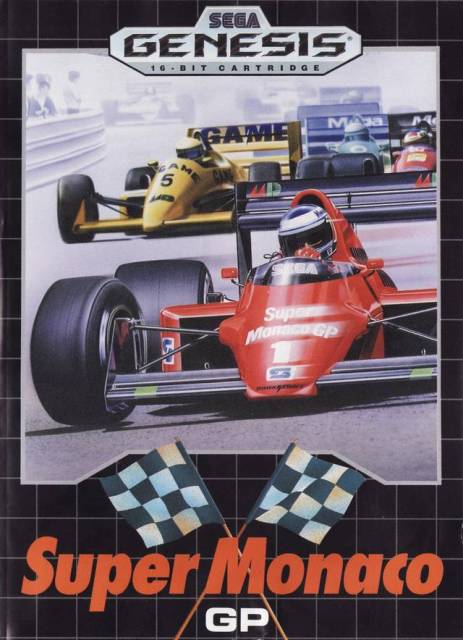
- Developer: Sega
- Publisher: Sega
- JP Release: 08/09/1990
- NA Release: September 1990
- EU Release: January 1991
- Franchise: Monaco Grand Prix
- Genre: Driving
- Theme: Motorsports
- Premise: The system's initial F1 game (and its first car racing game in general) was a strong first step for what would become one of the Mega Drive's most revisited genres, pushing the system's modest sprite-scaling tech to its limit and giving F1 fans a reasonable proximity of a career in an official team.
- Availability: There's not much call for a game based specifically on the 1989/1990 season of F1, but the game does have a 1992 sequel and a 1995 compilation rerelease.
- Preservation: Monaco GP is actually one of Sega's oldest properties, which made it an ideal choice for a big flashy reboot once they had better tech to work with (the Sega X arcade board and the 16-bit Mega Drive). I couldn't care less about F1 games, but it is remarkable how much better the sprite-scaling is here than in some of their earlier arcade conversions.
052: Rastan Saga II
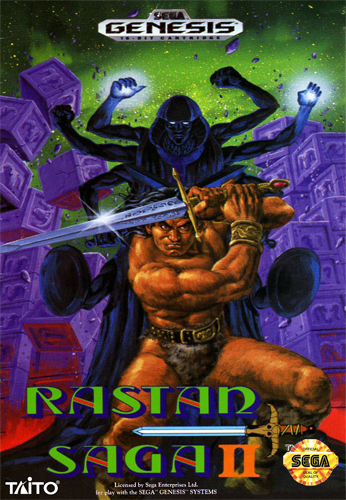
- Developer: Opera House
- Publisher: Taito
- JP Release: 08/10/1990
- NA Release: June 1991
- EU Release: N/A
- Franchise: Rastan
- Genre: Brawler
- Theme: Fantasy
- Premise: Leap into a world suspiciously like the Hyborian Age with Rastan, a sword- and shield-wielding warrior of little fear and even less clothing. Contractor Opera House worked on this so-so Mega Drive port of Taito's brawler.
- Availability: The Mega Drive version's never been rereleased, but the original arcade version is available on Taito Legends 2 for PS2, Xbox and GameCube (as Nastar Warrior).
- Preservation: I think if you were going to play Rastan Saga II today, you'd best stick with the arcade game in that Taito Legends 2 compilation. This doesn't seem like a particularly good conversion between its stiff movement, bad platforming and single-frame animations. I recall the PC Engine version being marginally better too.
053: Shadow Blasters / Shiten Myouou

- Developer: Cyclone System
- Publisher: Sage's Creation/Sigma Ent. Inc.
- JP Release: 08/10/1990 (as Shiten Myouou)
- NA Release: August 1990
- EU Release: N/A
- Franchise: N/A
- Genre: Brawler
- Theme: Fantasy/Martial Arts
- Premise: Four heroes are chosen by God to defend mankind from the evil Ashura. They all have names like Leo and Tiffany. We're doomed.
- Availability: Original MD/Gen cart only.
- Preservation: Cyclone/Sigma are very clearly aping Sega's Mystic Defender here, which is a game I'm not sure was exceptional enough to invite imitators. It has that similar risk vs. reward system where your charged shots are far more powerful, but having to sit there building them up leaves you vulnerable to the throngs of monsters swarming in. Not particularly great, but it does earn bonus points for calling its kunoichi "Tiffany". That's something I'd expect from the likes of Far Cry 3: Blood Dragon.
054: Michael Jackson's Moonwalker
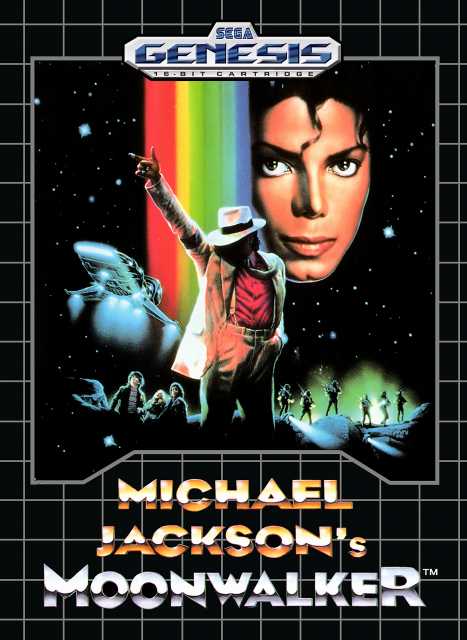
- Developer: Sega
- Publisher: Sega
- JP Release: 08/25/1990
- NA Release: August 1990
- EU Release: September 1990
- Franchise: N/A
- Genre: Platformer
- Theme: Crime
- Premise: Michael Jackson is here to *checks notes* save children in this licensed action game from Sega based on the 1988 movie of the same name.
- Availability: Unlikely to see a rerelease, let's just say.
- Preservation: For as controversial as this game might appear now, and ultimately pretty tragic too, it's not all that bad. The arcade game was better, if only because it benefited from being even weirder, but this worked as a reimagining of Shinobi (albeit with a magical dancing shapeshifter in a sharp white suit instead of a ninja) that was helped considerably by some great animations and workable renditions of the King of Pop's music.
055: XDR: X-Dazedly-Ray
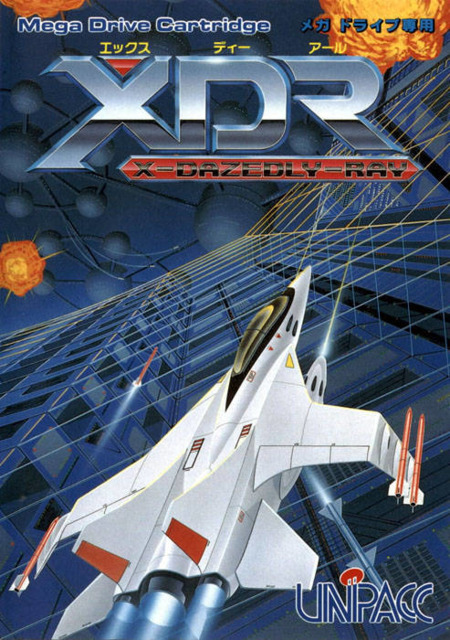
- Developer: Unipacc
- Publisher: Unipacc
- JP Release: 08/26/1990
- NA Release: N/A
- EU Release: N/A
- Franchise: N/A
- Genre: Shoot 'em Up (Horizontal)
- Theme: Sci-fi
- Premise: Planet Sephiroth was a chill place until the Guardia decided to invade, and now it's had to launch the XDR to defend itself. All shoot 'em ups have the same plot with different proper nouns. Shocker, I know.
- Availability: Japanese Mega Drive only.
- Preservation: You couldn't be further from "beggars can't be choosers" when it came to Mega Drive shoot 'em ups. That's probably why a lot of the also-rans, like XDR, didn't even try to break into the international market with the competition available. A mediocre Gradius clone, XDR has little to recommend it despite not being abjectly awful. It's forgettable is what it is, even with that bizarre name.
056: Klax
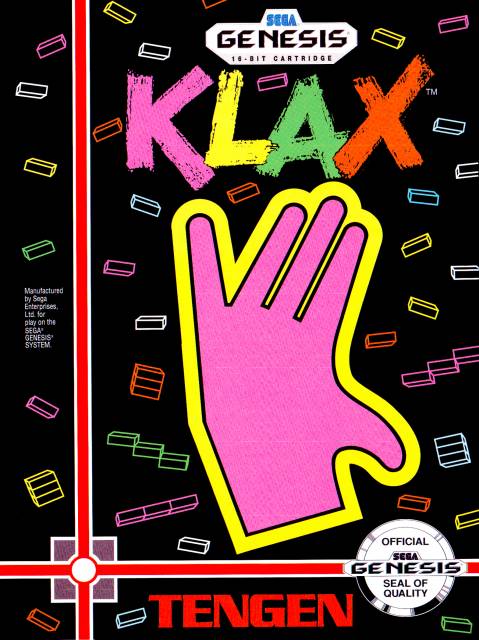
- Developer: Namco & Tengen
- Publisher: Namco & Tengen
- JP Release: 09/06/1990
- NA Release: 1991
- EU Release: November 1991
- Franchise: N/A
- Genre: Puzzle
- Theme: Abstract
- Premise: A colored block stacking game in which you see the blocks rolling down the conveyor belt way in advance. Klax is the noise the klaxes make when they klax their way towards you.
- Availability: As well as a huge number of contemporaneous releases for other systems, Klax was also part of Midway Arcade Treasures for PS2/Xbox/GameCube.
- Preservation: Atari were really stretching for a simple but addictive puzzle game to fill the gap left by the issues surrounding their publishing of Tetris, which they still technically owned the rights to but also technically didn't. So they had computer game developer Dave Akers knock together Klax over a weekend, which he was happy to do because his last game (this one) almost killed him. I've never held any great affinity for Klax like I have for Tetris or Columns or Dr. Mario, and neither has anyone else I've ever met, but I'm sure there are Klaxheads out there. It certainly sold well enough across its dozens of ports. Curiously enough, the Japanese version of Klax was developed and published by Namco instead, and is in some respects an entirely separate game but for the fact it still looks and plays like Klax.
057: Insector X
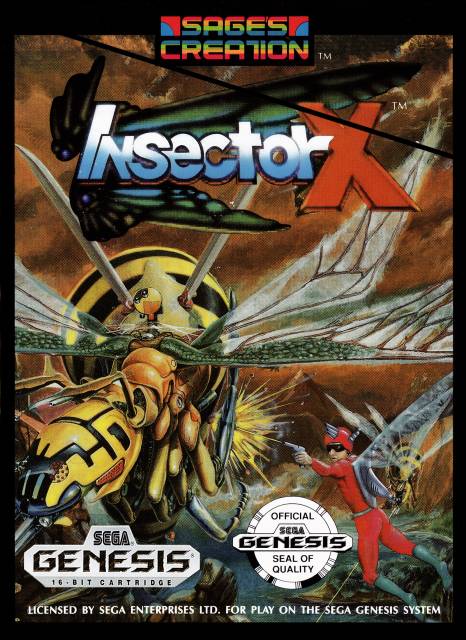
- Developer: Hot-B
- Publisher: Hot-B/Sage's Creation
- JP Release: 09/07/1990
- NA Release: October 1990
- EU Release: N/A
- Franchise: N/A
- Genre: Shoot 'em Up (Horizontal)
- Theme: Sci-fi
- Premise: Alien insects are invading and if you can't beat 'em, join 'em. That's what this one guy in a bee outfit is doing. Ant-Man & Wasp in cinemas now.
- Availability: As with the previous Taito game, Rastan Saga II, you can pick up the arcade version in the Taito Legends 2 compilation for PS2, Xbox and GameCube. The Mega Drive version never saw a rerelease though.
- Preservation: This is pretty funny. We've seen games that had their graphics edited for the North American market either because it had some anime license with no international presence or because the typically cutesy look that goes into some Japanese games wasn't thought to appeal to a global audience. Insector X is a case of the latter, except both the Japan and North American versions were changed from the arcade original to be darker and grittier. The port's developer Hot-B (which is a great name to have when working on an insectoid shoot 'em up) decided to toughen it up for probably no other reason than wanting to put their own spin on it. It's still a Taito shoot 'em up, so it's not bad, but what an odd thing to do with someone else's IP.
058: Space Invaders '91 / Space Invaders '90

- Developer: Taito
- Publisher: Taito
- JP Release: 09/07/1990 (as Space Invaders '90)
- NA Release: 1991
- EU Release: N/A
- Franchise: Space Invaders
- Genre: Shoot 'em Up (Single-Screen)
- Theme: Sci-fi
- Premise: Space Invaders is back and modernized for the 16-bit era. You'd think a shield gauge and power-ups would make defending the Earth easier, but nope.
- Availability: It somehow managed to avoid all the Taito and Space Invader compilations. Probably by moving to the side real fast.
- Preservation: Taito aren't stopping, huh? They were pretty infatuated with the Mega Drive around this time, porting as many of their arcade games over as they could find. This is technically a Mega Drive original, though it's building on the gigantic 1978 arcade hit that made Taito a household name. Adding new elements like a health gauge, power-ups and varied enemy types to contend with really adds a lot to the original experience, and it's a process Taito would continue to fine-tune in the many Space Invaders successors to follow.
059: Hellfire
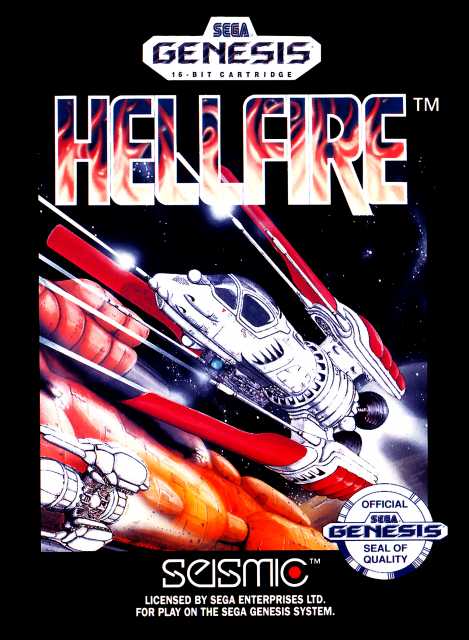
- Developer: Toaplan
- Publisher: Masaya / Seismic / Sega
- JP Release: 09/28/1990
- NA Release: November 1990
- EU Release: May 1992
- Franchise: N/A
- Genre: Shoot 'em Up (Vertical)
- Theme: Sci-fi
- Premise: It's [2998 CE] and the [Black Nebula] controlled by the evil [Super Mech] threatens mankind's colonist expansion into the stars. Only [Captain Lancer], his ship [CNCS1] and his ultimate weapon [Hellfire] can stop them!
- Availability: As well as the MD/Gen version, there are the Japan-only arcade and PC Engine CD-ROM versions. Nothing newer than that though.
- Preservation: Hellfire's got this cool system where you can cycle firing modes, reaching enemies in multiple directions. It eventually becomes a necessity to keep switching around in later levels and even in boss fights. Unfortunately, they kinda botched this port by having you respawn earlier in the level instead of on the spot where you died like in the arcade version, making it far harder than it needed to be. Darn.
060: Strider

- Developer: Sega
- Publisher: Sega
- JP Release: 09/29/1990
- NA Release: November 1990
- EU Release: May 1991
- Franchise: Strider
- Genre: Platformer/Brawler
- Theme: Sci-fi / Cyberpunk
- Premise: Strider Hiryu is tasked with saving the world from Grandmaster Meio with his trusty Cypher weapon and various robotic animal companions in this rad as hell cyberninja arcade game.
- Availability: Lots of places. The Mega Drive port was available on Wii Virtual Console, and the arcade version can be found in the Capcom Classics Collection Vol. 2 compilation. There's also the 2014 remake, available on Xbox One, PS4, and Steam.
- Preservation: This near perfect adaptation of the arcade Strider from Capcom was a coup for Sega and their campaign against Nintendo, and at this time was probably the best game of its type for the system. The large detailed sprites, the lightning fast pace, and unusual verticality are all preserved here and like Ghouls N' Ghosts the Sega Mega Drive was pretty much the best way to play that particular Capcom arcade game in your own home.
061: Rainbow Islands Extra
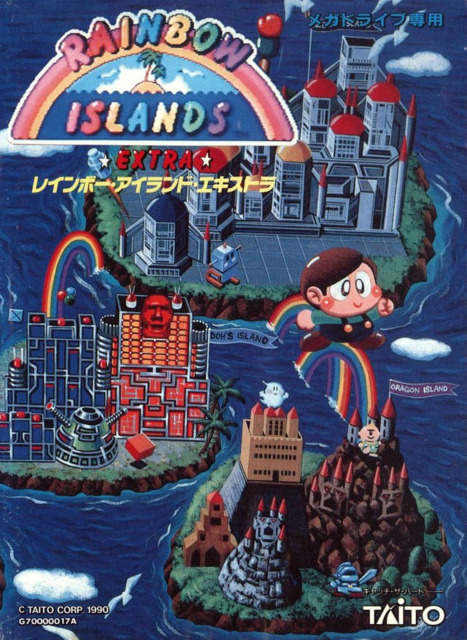
- Developer: Aisystem Tokyo
- Publisher: Taito
- JP Release: 10/05/1990
- NA Release: N/A
- EU Release: N/A
- Franchise: Bubble Bobble
- Genre: Platformer
- Theme: Fantasy
- Premise: Bub and Bob return in their human forms to chase after the nefarious Dark Shadow that previously cursed them with bubble dinosaur bodies. Instead of bubbles we have rainbows, which operate both as projectiles and as platforms needed to climb the game's vertical-scrolling levels.
- Availability: As one of Taito's most beloved games, Rainbow Islands has shown up several times in recent history, either as part of a compilation (Taito Legends) or a remake (Rainbow Islands Revolution for DS, Rainbow Islands Evolution for PSP, and Rainbow Islands: Towering Adventure! for WiiWare and XBLA). I don't think this specific Mega Drive version or the arcade variant it was based on were ever rereleased though.
- Preservation: Rainbow Islands for sure holds up. The gameplay's simple enough once you get used to the rainbows' fragility - you can't jump on 'em - but you'll eventually uncover a few of the game's secrets as you play and start to appreciate the game's depth. The "Extra" mode doesn't really do much but restructure the later stages to make them easier and put them first in the order, which essentially lets you see what the end-game enemies and bosses are like in case you were never good enough to get there with the game's original level order. It's a bit flickery and laggy as ports go, but it retains the look at least.
062: Bimini Run

- Developer: Microsmiths
- Publisher: NuVision
- JP Release: N/A
- NA Release: 10/10/1990
- EU Release: N/A
- Franchise: N/A
- Genre: Vehicular Combat (with boats!)
- Theme: Espionage/Crime
- Premise: "Kenji, come in!" This Miami Vice-styled action game has Kenji and his partner Luka chase the evil Dr. Orca across various islands off the coast of Florida, destroying enemy ships and radio towers from the bow of their red speedboat.
- Availability: North American Genesis only.
- Preservation: Bimini Run's only the second Genesis game we've seen so far without a Japanese release. Microsmiths were formed from ex-Activision people and didn't last long (though its staff quickly found other positions in the industry), but they left us with this ambitious proto-Desert Strike-but-in-a-boat where you're given constant updates from HQ to complete objectives across a persistent map. It's another Jeff favorite also: here's his 2012 Encyclopedia Bombastica on the game if you wanted more information.
063: Final Zone / FZ Senki Axis
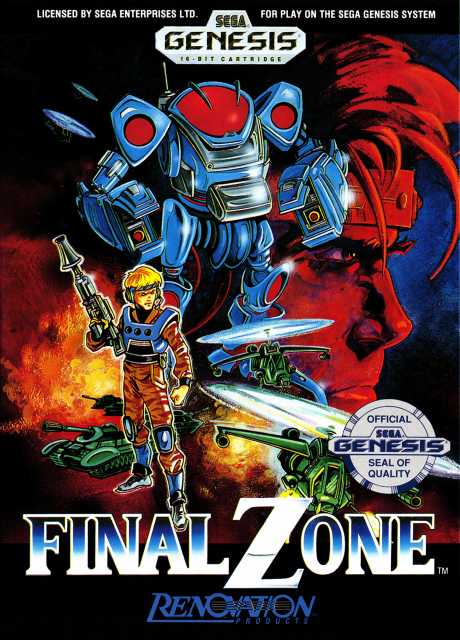
- Developer: Wolf Team
- Publisher: Wolf Team / Renovation
- JP Release: 10/12/1990 (as FZ Senki Axis)
- NA Release: December 1990
- EU Release: N/A
- Franchise: Final Zone
- Genre: Shooter (Top-Down)
- Theme: Sci-fi - Mecha
- Premise: In the future, weapons of mass destruction have been outlawed and combatants instead fight in mecha suits, called New Age Power Suits. The player's role in this isometric top-down shooter is to eliminate the last few WMDs on Earth.
- Availability: MD/Gen cart only.
- Preservation: Mega Archive welcomes Wolf Team to the feature. Like Square, it was one of those versatile hard-working Japanese devs that didn't really get anywhere until their big JRPG break - in Wolf Team's case, that was the 1995 Super Famicom RPG Tales of Phantasia, which spawned a franchise that continues strong today. A lot of Wolf Team's games were strategy-related, like the Zan series, but Final Zone resembles more of a Masaya Assault Suits action game in practice. This Final Zone is actually a spin-off in the series - the first was computer only, and the second was released for the TurboGrafx-CD. I guess it seemed odd to TGCD owners that Final Zone II was released earlier than Final Zone for Mega Drive.
064: Slaughter Sport / Fatman
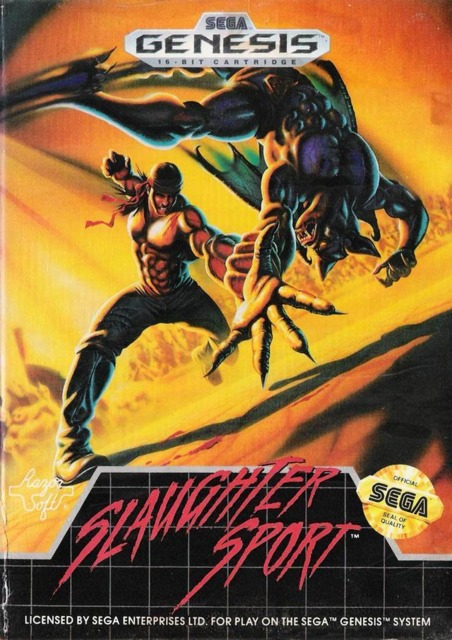
- Developer: Activision
- Publisher: Sanritsu Denki / Razorsoft
- JP Release: 10/12/1990
- NA Release: December 1991
- EU Release: N/A
- Franchise: N/A
- Genre: Fighter
- Theme: Sci-fi / Horror? Definitely "Weird".
- Premise: Welcome to Mondu's Fight Palace, an intergalactic arena for the strongest and freakiest warriors in the cosmos. Do you have what it takes to beat Mondu himself?
- Availability: It was originally a PC game, but I don't think anyone's champing at the bit to get it added to GOG or Steam.
- Preservation: Anyone hoping for a Street Fighter or a Mortal Kombat as the system's first fighter game is out of luck, because what you got was this sublimely strange and acutely awful MS-DOS fighter with an aesthetic that feels vaguely cribbed from Marvel's Mojoworld or some long-forgotten 2000AD strip. It has a few novel ideas, like capturing the "souls" of defeated fighters before you could use them and betting on your own matches to earn fight money for power-ups, but the actual gameplay is this broken mess where you can either complete the game in minutes or get stymied by the first battle. Apparently Activision was going through some hard times in 1990 and this buggy version of the game could well have been the work of its Japanese publisher, Sanritsu. One for Giant Bomb's science team to investigate, for sure.
065: Burning Force

- Developer: Nova
- Publisher: Namco / Sega
- JP Release: 10/19/1990
- NA Release: 1990
- EU Release: December 1991
- Franchise: N/A
- Genre: Shoot 'em Up (Z-Axis)
- Theme: Sci-fi
- Premise: The Z-Axis shooters are back, only this time it's a Namco property. Help Hiromi pass her space cadet exam over a week of high-octane exercises.
- Availability: Namco has what feels like a hundred compilations but Burning Force isn't on any of them as far as I'm aware. There was a 2009 Virtual Console release of the arcade version, but it's Japan-only.
- Preservation: I'm sure we'll be seeing Hiromi in a future episode of JeffRud's NamCompendium series, but it seems Burning Force didn't really make much of a splash for Namco despite being a fairly cool take on the Space Harrier formula with a great soundtrack, fluid movement, and a cute heroine that would join Namco's stable of female mascots along with Wonder Momo, Valkyrie, and Druaga's Princess Ki. She'll show up later in the Japan-exclusive PS2 strategy-RPG Namco X Capcom, itself a precursor of the Project X Zone games for 3DS.
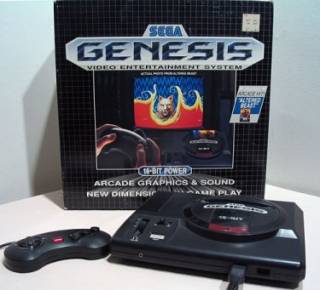
Log in to comment